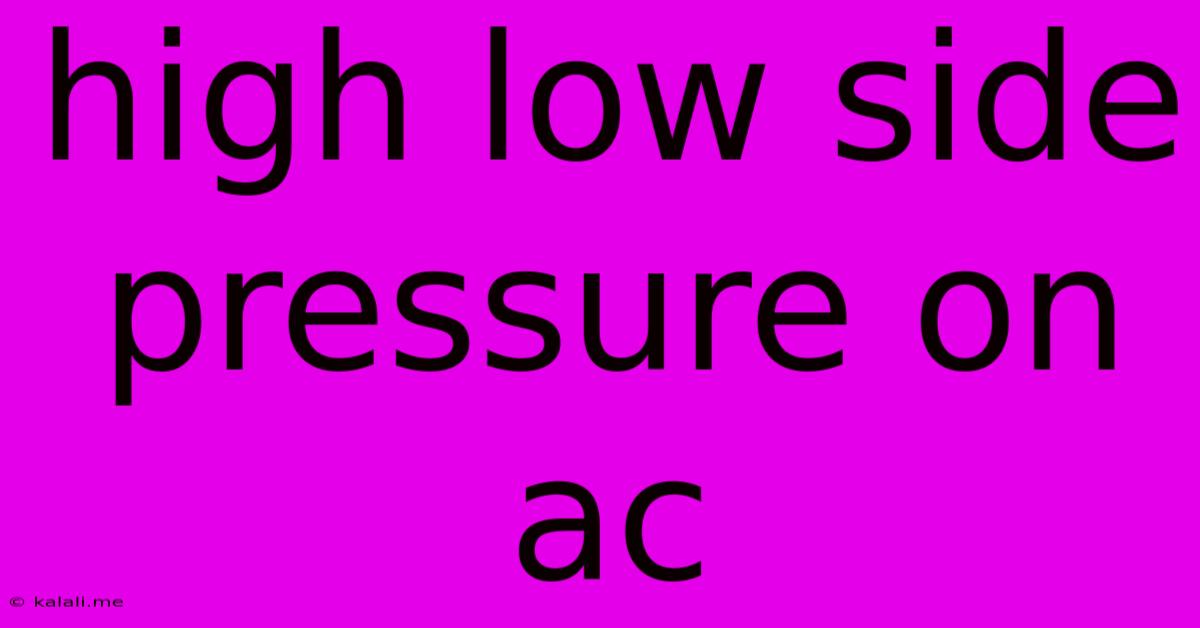High Low Side Pressure On Ac
Kalali
Jun 01, 2025 · 3 min read

Table of Contents
High-Low Side Pressure on AC: Troubleshooting and Solutions
This article will guide you through understanding high and low side pressures in your air conditioning system, common causes for imbalances, and troubleshooting steps to resolve these issues. Understanding your AC's pressure readings is crucial for efficient cooling and preventing costly repairs. This comprehensive guide will equip you with the knowledge to diagnose and, in some cases, fix AC pressure problems yourself.
What are High and Low Side Pressures?
Your AC system uses refrigerant, a crucial component that absorbs heat from your home and releases it outside. The refrigerant circulates through two main sides: the high-pressure side (discharge side) and the low-pressure side (suction side). These pressures are measured in pounds per square inch (PSI) and are critical indicators of your system's health. Ideal pressure readings vary depending on the specific AC unit and refrigerant used, so always consult your owner's manual for the recommended operating pressures.
Understanding the Pressure Imbalance
An imbalance between the high and low side pressures indicates a problem within your AC system. A high-pressure reading might indicate restrictions in the refrigerant flow, while a low-pressure reading usually suggests insufficient refrigerant. These imbalances can lead to inefficient cooling, increased energy consumption, and even system failure.
Common Causes of High-Side Pressure
- Restricted Airflow: Dirty air filters, clogged condenser coils, or restricted airflow around the outdoor unit can significantly increase high-side pressure. These obstructions hinder the release of heat, forcing the compressor to work harder.
- Faulty Compressor: A failing compressor can't effectively pump refrigerant, leading to a buildup of pressure on the high side. This is a serious issue that requires professional attention.
- Overcharged Refrigerant: Too much refrigerant in the system can create excessive high-side pressure. This is less common than undercharging but equally problematic.
- Condenser Fan Issues: A malfunctioning condenser fan is unable to adequately dissipate heat, resulting in a pressure increase.
- Clogged TXV (Thermostatic Expansion Valve): A clogged TXV restricts the flow of refrigerant to the evaporator, increasing pressure on the high side.
Common Causes of Low-Side Pressure
- Refrigerant Leak: This is the most frequent cause of low pressure. Leaks can occur anywhere in the refrigerant lines and require professional repair. Regular inspections can help prevent catastrophic leaks.
- Undercharged Refrigerant: Simply put, not enough refrigerant in the system. This requires professional recharging.
- Compressor Issues: A faulty compressor might not be able to pull enough refrigerant, resulting in low suction pressure.
- Evaporator Fan Issues: A malfunctioning evaporator fan restricts airflow over the evaporator coils and lowers suction pressure.
- Blocked Suction Line: A blockage somewhere in the suction line can prevent proper refrigerant flow.
Troubleshooting Steps
- Check the Air Filters: Replace or clean dirty air filters. This is the easiest and often the most effective initial step.
- Inspect the Condenser Coils: Clean or replace dirty condenser coils. This improves airflow and heat dissipation.
- Examine the Condenser Fan: Ensure the condenser fan is operating correctly and is not obstructed.
- Check for Refrigerant Leaks: Look for signs of leaks, such as frost or ice buildup in unexpected areas. This requires professional assessment and repair.
- Verify Refrigerant Charge: This is a task best left to qualified HVAC technicians. Improper refrigerant charging can damage your system.
When to Call a Professional
While some minor issues can be addressed with simple maintenance, tackling more significant problems, like refrigerant leaks or compressor failure, requires the expertise of a qualified HVAC technician. Attempting repairs beyond your skill level can lead to further damage and increased costs. Always prioritize safety and call a professional if you're unsure about any aspect of your AC system.
Remember, this article is intended for informational purposes only and does not constitute professional HVAC advice. Always consult a qualified technician for diagnosis and repairs of your air conditioning system.
Latest Posts
Latest Posts
-
Why Was The Film Called Seven Pounds
Jun 03, 2025
-
How To Tell If Acorn Squash Is Ripe
Jun 03, 2025
-
Steam Share A Game That Hasnt Been Played
Jun 03, 2025
-
This Is Her Or This Is She
Jun 03, 2025
-
How To Change A Spiral Notebook Cover
Jun 03, 2025
Related Post
Thank you for visiting our website which covers about High Low Side Pressure On Ac . We hope the information provided has been useful to you. Feel free to contact us if you have any questions or need further assistance. See you next time and don't miss to bookmark.